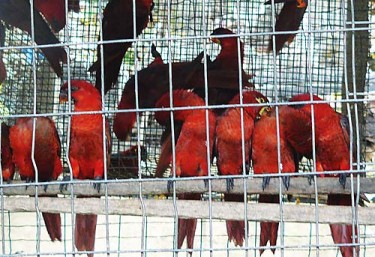Many endangered birds sold as captive bred have actually been caught in the wild [1] and smuggled out of their original habitats under cruel conditions, according to a July 2012 report [2] from the Wildlife Trade Monitoring Network (TRAFFIC).
Wild birds traded as captive bred
More than 54,000 birds, mainly parrots and cockatoos, were imported from the Solomon Islands between 2000 and 2010 as ‘captive bred’. These included birds non-native [3] to the Solomon Islands. However, local authorities confirmed to TRAFFIC that the islands have no substantial bird breeding facilities and that registered bird breeders there mainly use their premises as holding sites for illegally caught wild birds bound for export.
The Consumers Association in Penang [4], Malaysia described how wild birds are caught:
Various methods of capture are used; one is the use of live decoy birds of the target species, which are tied by a foot to a peg in the ground with wing tips hacked off to prevent escape. Another is liming; coating a branch with a sticky substance from fresh fruit and honey. Birds trapped in this manner die a slow death as they hang upside down for hours. More commonly used is the mistnets. These nets spread across the flight paths of birds are often left up for long periods, resulting in slow agonising deaths [..]
Birds are drugged with phenobarbitol or valium, stuffed into short lengths of plastic or wire mesh tubing, then put into suitcases modified to allow air circulation and be carried by hand. They are then taken on normal passenger flights to intermediary places like Singapore or Thailand or to their country of destination.
Trading route of wild birds
YouTube user vladi0361 [5] shared the Environmental Investigation Agency's [6] investigation of the illegal trade of wildly caught parrots in Africa and Southern America [Warning: This video contains cruel content]:
Many birds referred to in the TRAFFIC report are listed [7] in the Convention on International Trade in Endangered Species of Wild Flora and Fauna (CITES [8]), which restricts trade in wild caught individuals. However, bird traders have been making use [9] of the loophole of ‘captive-bred’ to get around the international regulations. The TRAFFIC report described [1] the wild bird trading routes:
Over the past decade, Singapore and Malaysia combined have accounted for 93% of all birds imported from the Solomon Islands, with significant numbers being re-exported, especially to Taiwan.
Although the above three countries listed have domestic regulations to stop illegal trade of wild birds, enforcement of the law is not effective. So what has gone wrong in these countries?
Singapore: Stringent laws not stopping wild bird trade
Singapore became a Signatory to CITES in 1986. Under the Endangered Species [10] (Import and Export) Act, it is an offence to import and export any endangered species without a permit. Any person or company caught violating the law will be prosecuted in Court and subjected to a large fine or even imprisonment.
The Animal Concerns Research & Education Society (ACRE) pointed out [10] that despite these stringent laws, Singapore is still considered a major centre for trade in illegal wildlife:
Prohibited wild animals continue to be advertised for sale as pets in Singapore over the internet, which is also an offence under Singapore law.
Malaysia: Local support needed for the enforcement of CITES
Although the Malaysian government has tried to stop illegal importation of wild birds by requiring traders to declare the origin [1] of all imported birds, the Penang Consumers Association [11] believes governments should take more responsibility for implementation of CITES:
The Convention on International Trade in Endangered Species of Wild Flora and Fauna (CITES) lacks teeth to protect species against illegal traders act. It is only a treaty and not a law enforcement body with its signatories expected to implement the treaty’s provisions through domestic legislation and agencies [..] Its challenge is to muster the political support necessary to push wildlife trafficking on national agendas and stir law enforcement officials into effective action. The war against traffickers must be waged at the highest level of government.
The association also urged consumers [4] to take action and stop the trade.
Taiwan: Market flooded with wild bird trade
An article [12] [zh] in a Taiwanese forum for parrot lovers described the illegal trading of these birds:
台灣的販賣野生鸚鵡幾乎已到氾濫的地步,販賣野生鸚鵡的鳥店比比皆是,那些野生鸚鵡通常在走私至出口國時因殘忍的走私運送死傷慘重,到了出口國經過神不知鬼不覺手段依然可以合法的出口,所以這是許多販賣野生鸚鵡的鳥店都經合法進口過程,也有合法文件的原因…對於合法進口的野生鳥經合法程序有合法文件根本無從抓起,販賣走私鸚鵡的暴利是很少鳥店不賺的,因為國外進口的人工繁殖鳥的價錢往往大大地遠高於野生鳥價錢.
On the one hand, Taiwan is importing the wild birds, but according to a report from Public Television Service Taiwan [13] [zh], the island is also a parrot export region:
目前的寵物鳥市場,鸚鵡就佔了七成,鸚鵡外銷年產值高達七十億,但是國內市場卻沒有人統計。…究竟台灣有多少繁殖場?有多少販售據點?有多少鸚鵡在市場上流通?沒有人知道。…目前大型繁殖場所產出的鸚鵡,大多銷往韓國、日本、中東、 美國以及大陸。
This report also explained that to differentiate between birds bred legally in Taiwan and smuggled birds, from April 2011, the Taiwanese government has assigned individual parrots a distinctive ID.
This post was sub-edited by Jane Ellis [14].
